We use cookies to improve your experience. By accepting you agree to our cookie policy
Phoebe’s story is a rollercoaster of highs and lows, but discovering Calmare Scrambler Therapy as a CRPS treatment changed her life. Phoebe, Mum Rachel, and Dad Mick are now on a mission to raise awareness of the non-invasive treatment in a bid to support other CRPS patients and help them find relief.
This is her journey.

In 2022, during a school basketball game, Phoebe severely injured her knee. Despite multiple visits to the Polyclinic, she was initially misdiagnosed (like many CRPS patients) with a sprain. After several months of pain, swelling and mobility issues, however, she was later informed it was, in fact, a double knee fracture. While it had begun to heal, the knee needed support and Phoebe’s entire leg was quickly put into a full-length plaster cast.
Removing the cast, however, led to even further complications, underlining increased sensitivity, pain and immobility in the affected area. Within a few weeks of removing the cast, Phoebe and her family noticed discolouration, notable temperature differences, and extreme hypersensitivity.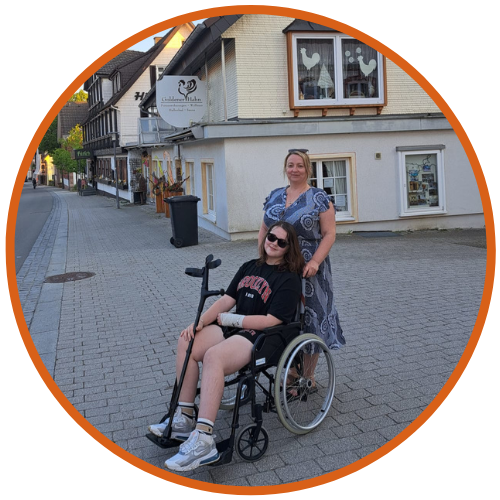
As the symptoms escalated, Phoebe was put on a “cocktail of pain relief” and started hydrotherapy. "Although the hydro gave her some respite in the pool, once out her leg would be purple/black and the pain would quickly return," recalled her mother, Rachel.
The family returned to the initial consultant, who referred them to a colleague specialising in Pain Management. It was then that Phoebe was finally diagnosed with Complex Regional Pain Syndrome (CRPS).
The diagnosis was a double-edged sword. On one hand, it provided a name for the excruciating pain and myriad symptoms Phoebe was experiencing. On the other, it opened the door to a challenging and often misunderstood condition that would require a multi-faceted approach to manage.
Despite the medical support received, traditional treatments made little difference to Phoebe's condition. The medication had worrying side effects, and the family was desperate for a solution that would address the root cause of her pain, rather than just numbing it.
Amid their struggle, a particularly harrowing weekend marked a turning point for the family.
"After a particularly horrific weekend where Phoebe was unable to move without screaming in pain, hitting her head against a wall to try and distract the pain signals and breaking down after the realisation of how debilitating the condition was,” said mum Rachel, “We literally sat on the computer and searched for hours and hours for more information and treatments.”
Frustrated with the lack of progress and concerned about the side effects of the medications Phoebe was taking, the family took matters into their own hands.
"We wanted to attack the cause of her pain and make it go away long term, not just drug her to try and numb it," Rachel explained. It was during this exhaustive search that they stumbled upon a post mentioning Calmare Scrambler Therapy and how it can be used as a CRPS treatment.
Initially sceptical, the family delved deeper into their research, eventually finding a Facebook page where a lady from the UK discussed how Scrambler Therapy had helped her. This led them to discover that treatment options were available closer to home—in Ireland, Italy, and Germany, not just in the United States.
Their research led them to Dr Markus Seuthe in Baiersbronn, Germany, who had recently trained with Dr Michael Cooney, a highly recognised advocate of Scrambler Therapy in the USA. The family arranged a video call with Dr Seuthe for the morning of Easter Monday.
Within minutes of talking to Dr Seuthe, they realised how passionate he was about treating the root cause of the pain problems, particularly with CRPS. He took the time to clearly explain the procedure and the outcomes he had achieved so far, answering all of their questions.
One of Phoebe's main concerns was whether the treatment would involve needles.
"Markus explained no needles were involved, much to her delight, and showed her the electrodes he would place around the pain site," said Rachel. To alleviate concerns about Phoebe's hypersensitivity, Dr Seuthe even demonstrated the removal of the electrodes on himself to show it wouldn't hurt.
"He answered all our questions and gave up his time freely, with no pressure to commit," Rachel adds.
Yet, the minute they finished the call, the family felt a tiny glimmer of hope and excitement for what could be.
"By the following morning, we had contacted Markus to say we wanted to commit to the therapy, and within nine weeks, we were travelling to Germany," Rachel recalls.
Calmare Scrambler Therapy is a non-invasive and non-pharmaceutical approach to treating chronic nerve pain, including CRPS.
"Calmare can be particularly effective for people newly diagnosed with CRPS and those who have exhausted traditional pain management options," explained Dr Michael Cooney, a leading clinician in the field.
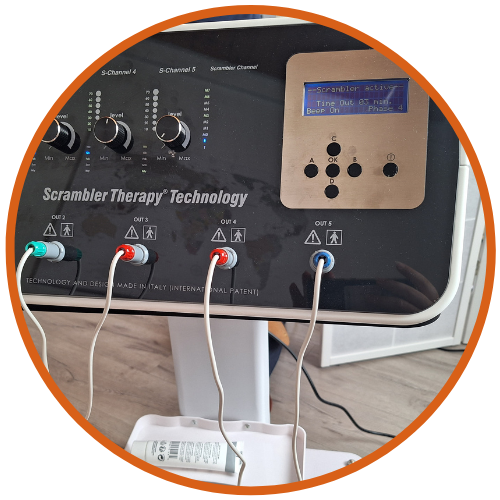 How Does It Work?
How Does It Work?The principle behind Calmare Therapy is both innovative and straightforward.
When someone sustains an injury, the brain initiates a healing process and continues to send pain signals until the injury is healed. For some individuals, however, the brain never stops sending these pain signals, even after the injury has healed. This is where Calmare comes into play.
Using small electrodes—similar to those used in a heart EKG— "The scrambler machine 'overrides' the brain’s confused 'pain here' message and corrects it to the 'no pain here' message," Dr Cooney elaborated.
Calmare is FDA-cleared and European CE mark-certified, adding a layer of credibility to its efficacy. Dr Cooney, who has treated more than 1,000 CRPS patients since 2011, notes that "75% of the CRPS patients I have treated have significantly reduced—or even eliminated—their neuropathic pain and physical symptoms."
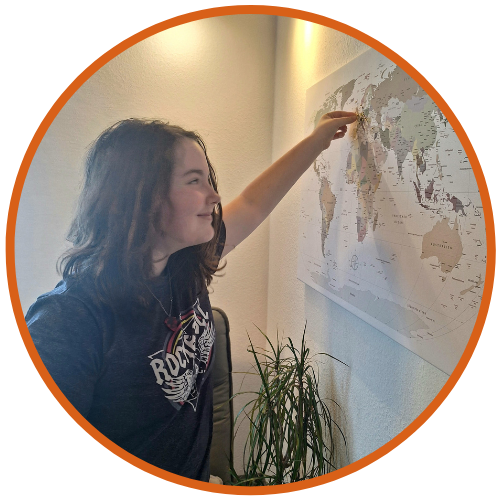
The family's journey to Germany was no small feat. They flew from Heathrow to Stuttgart, a flight that lasted around 1 hour and 40 minutes, and then were transferred to Baiersbronn, adding another 1 hour and 20 minutes to their journey.
"We used assistance at the airports, which was invaluable, especially the staff at Stuttgart who went above and beyond to help a self-conscious 13-year-old and two harassed and exhausted parents," Rachel mused.
"To allow her to be more responsive to treatment, Markus advised she came off pain meds, which we did slowly before flying out," Rachel said. “She did need to take diazepam for the flight but he said this would be OK and would rather she did this than be in pain.”
Before the official treatment began, Dr Seuthe met with the family to discuss the procedure and to conduct a trial positioning of the electrodes.
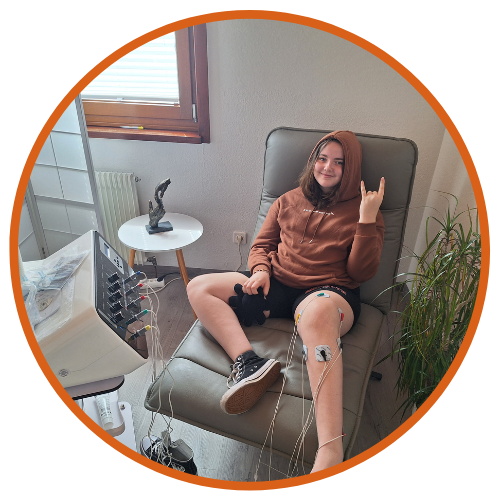 The treatment itself was non-invasive and had no side effects, apart from potential tiredness.
The treatment itself was non-invasive and had no side effects, apart from potential tiredness.
"Phoebe initially described it as a pins and needles sensation which then turned to a gentle vibration," Rachel recounted.
Sessions lasted between 45 minutes to an hour, and Phoebe was in control of the machine's settings at all times.
"Markus was keen to explain that it didn't matter if it was turned to a 1 or a 10, as long as you were feeling the vibration, the messages in the neurological pathways were being scrambled," Rachel noted.
While in Baiersbronn, Dr Seuthe took the opportunity to review Phoebe's MRI results and discovered untreated tendinitis in her foot. Recognising that this was contributing significantly to her foot pain, he decided to address it alongside the CRPS treatment.
"Markus kindly treated the tendinitis with Pulse therapy, pointing out that there was no point in addressing one problem and not the other," Rachel explained.
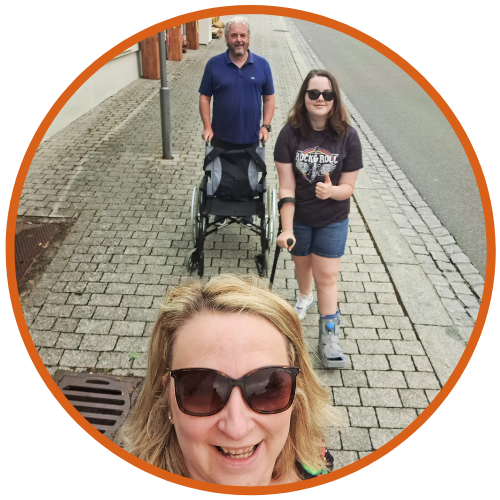
The impact of Calmare Scrambler Therapy on Phoebe was immediate and profound.
"On the first day of treatment, Phoebe managed to place her foot flat on the floor, something she hadn't done for four months," Rachel recalled.
The treatment also led to a significant reduction in her pain levels.
"By day 5, her pain levels were significantly reducing, and the effects were lasting," added Rachel.
The long-term outcomes have been transformative, not just for Phoebe but for her entire family.
"Phoebe has her childhood back! From being a bed-bound 13-year-old, in excruciating pain, depressed, missing out on her passions of drumming and skateboarding, we now have a happy, confident 13-year-old," Rachel said.
Phoebe has returned to school and resumed her hobbies, including drumming and skateboarding. Her mental health has improved, and Rachel notes the family dynamic has also shifted - "Where we were all living under the dark cloud of CRPS, there is now sunshine in our lives and hope," Rachel reflected.
“We will be forever in debt to… fellow CRPS sufferers and their families who gave invaluable support when researching the treatment and, of course, to Markus Seuthe, who we will forever carry in our hearts."
"Our dream is that this machine can be available in the UK," Rachel said, emphasising the importance of sharing their story to help others. “If we can help just one person gain relief from the relentless pain then it will be worth it.”
Every November is Complex Regional Pain Syndrome Awareness Month and, while there are lots of events and fundraisers taking place, we know not everyone is able to run a marathon, have a homemade cake sale or give a speech in front of hundreds of people!
So, this month, here are some other ways you can help raise CRPS awareness:
This November, if you’re raising CRPS awareness or able to Fundraise for Burning Nights or Make a Donation to help us support thousands of CRPS patients, loved ones and carers each year, we THANK YOU for your support!